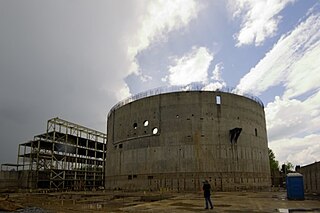The Black Fox Nuclear Power Plant was a nuclear power plant proposed by the Public Service Company of Oklahoma (PSO) in May 1973. It was cancelled in 1982.
The facility was to be built approximately 3 miles southwest of downtown Inola, Oklahoma, but still within town limits, and was to consist of two 1,150 MWe General Electric (GE) Boiling Water Reactors. The estimated cost of construction in 1973 was $450 million. By 1979, the amount had grown to $3.4 billion.
On June 2, 1979, just two months after the partial meltdown at the Three Mile Island nuclear power plant in Pennsylvania, a group of people climbed over the barbed wire fence that surrounded the Black Fox Power Plant. Protesters carried their backpacks, tents and acoustic guitars in an attempt to disrupt construction and camp out overnight. About 500 people were arrested for protesting.
On February 16, 1982, Public Service Company of Oklahoma canceled the Black Fox project. After nine years of court and legal challenges by Carrie Barefoot Dickerson and the Citizen's Action for Safe Energy (CASE) group, and $555,000, they would win against PSO. [1] [2]
On March 13, 2017 the Inola City Council unanimously voted to rezone the property owned by AEP/PSO from AG agricultural to I-4 Heavy Industrial. Since then, AEP/PSO has presented 1,000 acres of the former plant for development. [3] On March 16, 2018, Sofidel America, a paper manufacturing company with global headquarters in Italy, held a groundbreaking ceremony for their new 1.8-million-square-foot plant with a $360-million capitol investment. The Sofidel project involves 500 construction jobs and 300 permanent jobs. The new plant will cover 50 acres under one roof. Sofidel bought 240 acres from PSO, which still has 750 acres around it for sale. PSO sold the land for just over $1 million ($4166.66 an acre). [4]
Inola is a town in Rogers County, Oklahoma, United States. It is included in the Tulsa Metropolitan Statistical Area (TMSA). The population was 1,788 at the 2010 census, a 12.5 percent increase from 1,589 at the 2000 census. Inola is a Cherokee word meaning "Black Fox." The town styles itself as "The Hay Capital of the World."

American Electric Power (AEP), is a major investor-owned electric utility in the United States, delivering electricity to more than five million customers in 11 states.

The Bellefonte Nuclear Generating Station (BLN) is an unfinished nuclear power plant in Hollywood, Alabama, United States.

Donald C. Cook Nuclear Plant is a nuclear power plant located just north of the city of Bridgman, Michigan which is part of Berrien County, on a 650-acre (260 ha) site 11 miles south of St. Joseph, Michigan, United States. The plant is owned by American Electric Power (AEP) and operated by Indiana Michigan Power, an AEP subsidiary. It has two nuclear reactors and is currently the company's only nuclear power plant.

The Shoreham Nuclear Power Plant was a completed General Electric nuclear boiling water reactor located adjacent to Long Island Sound in East Shoreham, New York.

DTE Energy is a Detroit-based diversified energy company involved in the development and management of energy-related businesses and services in the United States and Canada. Its operating units include an electric utility serving 2.2 million customers and a natural gas utility serving 1.3 million customers in Michigan.

The William H. Zimmer Power Station, located near Moscow, Ohio, is a 1.35-gigawatt coal power plant. Planned by Cincinnati Gas and Electric (CG&E), with Columbus & Southern Ohio Electric and Dayton Power & Light (DP&L) as its partners, it was originally intended to be a nuclear power plant. Although once estimated to be 97% complete, poor construction and quality assurance (QA) led to the plant being converted to coal-fired generation. The plant began operations in 1991. Today, the plant is owned and operated by Vistra Corp.

The Cherokee Nuclear Power Plant is an uncompleted energy project 10 miles (16 km) outside Gaffney, South Carolina, United States. In the early 1970s, Duke Power started construction on a three-reactor nuclear power plant at the site. However, the project stalled due to economic problems by the early 1980s, leading to the project's eventual abandonment. In 1987, the power plant was the site of an underwater film studio built by Hollywood director James Cameron, for the film The Abyss.

Marble Hill Nuclear Power Station was an unfinished nuclear power plant in Saluda Township, Jefferson County, near Hanover, Indiana, USA. In 1984, the Public Service Company of Indiana announced it was abandoning the half-finished nuclear power plant, on which $2.5 billion had already been spent.
The Namie-Odaka Nuclear Power Plant was a planned nuclear power plant in Minamisōma and Namie in the Fukushima Prefecture, Japan. It was a project of the Tōhoku Electric Power Company. Preliminary ground work had been completed by the time of the 2011 Tōhoku earthquake and tsunami. The plans were canceled after urging from local lawmakers in the wake of the Fukushima Daiichi nuclear disaster and due to strong local opposition. On January 31, 2017, Tohoku Electric decided to donate the site of about 1.2 million square meters to Namie Town free of charge.

The anti-nuclear movement in the United States consists of more than 80 anti-nuclear groups that oppose nuclear power, nuclear weapons, and/or uranium mining. These have included the Abalone Alliance, Clamshell Alliance, Committee for Nuclear Responsibility, Nevada Desert Experience, Nuclear Information and Resource Service, Physicians for Social Responsibility, Plowshares Movement, Women Strike for Peace, and Women's International League for Peace and Freedom. Some fringe aspects of the anti-nuclear movement have delayed construction or halted commitments to build some new nuclear plants, and have pressured the Nuclear Regulatory Commission to enforce and strengthen the safety regulations for nuclear power plants. Most groups in the movement focus on nuclear weapons.
The 1970s proved to be a pivotal period for the anti-nuclear movement in California. Opposition to nuclear power in California coincided with the growth of the country's environmental movement. Opposition to nuclear power increased when President Richard Nixon called for the construction of 1000 nuclear plants by the year 2000.
Carrie Barefoot Dickerson was an American activist who led citizen efforts to stop construction of the proposed Black Fox Nuclear Power Plant in Oklahoma.

The Sundesert Nuclear Power Plant was a proposed California nuclear power station, formally submitted in 1976. Facing firm opposition from the state's Governor Jerry Brown and denied a permit by a state agency, plans for the construction of the power facility were rejected in 1978 after 100 million dollars had been spent towards its construction. The Sundesert proposal was the last major attempt to build a nuclear plant in California.
The Allens Creek Nuclear Power Plant was a proposed nuclear power plant to be located at Wallis, Texas, less than 50 miles from the western edge of Houston. The plant, consisting of two 1,150 MWe General Electric boiling water reactors, was ordered by Houston Lighting and Power Company (HL&P) in 1973, but public opposition, fueled in part by press coverage of problems at other nuclear plants around the country, led to lengthy public hearings and court action. In the meantime, construction costs escalated and the plant was officially canceled in 1982.

The U.S. State of Oklahoma has high potential capacity for wind power in the western half of the state. In 2017, Oklahoma's installed wind generation capacity was almost 7,500 megawatts, supplying almost a third of the state's generated electricity.

Cardinal Power Plant is a 1.8-gigawatt coal power plant located south of Brilliant, Ohio in Jefferson County, Ohio. The power plant has three units. Cardinal is co-owned with Unit 1 owned by American Electric Power's (AEP) subsidiary, AEP Generation Resources. Units 2–3 are owned by Buckeye Power, a utility cooperative. It began operations in 1967.

Conesville Power Plant was a 2-gigwatt, coal power plant located east of Conesville, Ohio in Coshocton County, Ohio. Its units were co-owned at the time of its closing by American Electric Power (AEP) and AES Ohio Generation. All plant operations were handled by AEP. Conesville began operations in 1957 and ceased generation in April 2020.

In 1899, the Vinita Electric Light, Ice and Power Company, which was headquartered in the Indian Territory town of Vinita obtained a charter to provide electric power to that community. In 1913, the company consolidated with similar independent companies in Tulsa, Guthrie, Coalgate, Lehigh and Atoka to form a new company, named Public Service Company of Oklahoma (PSO). The founder and first president of PSO was Frederick William "Fred" Insull, who moved the company's headquarters to Tulsa in 1916.

Anti-nuclear protests in the United States have occurred since the development of nuclear power plants in the United States. Examples include Clamshell Alliance protests at Seabrook Station Nuclear Power Plant, Abalone Alliance protests at Diablo Canyon Power Plant, and those following the Three Mile Island accident in 1979.